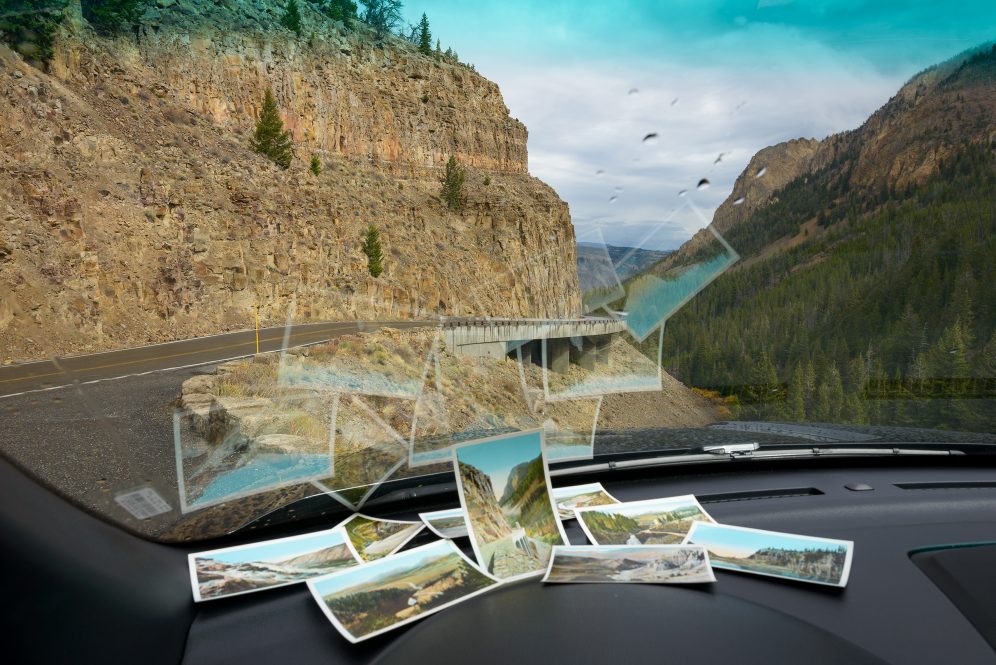Ask Janet Pritchard about her favorite spot inside Yellowstone National Park and she’ll tell you it’s wherever you can find the fewest people that day.
Not that the UConn photography professor abhors standing beside other visitors to take in the magnificence of the country’s first national park.
Rather, she likes to regale others with stories about how, to her ear, the bugle of a bull elk sounds like a double reed instrument in an orchestra and how bison outgassing smells much like marijuana.
She just doesn’t want to be shoulder-to-shoulder with other visitors, preferring the comfort of being behind a camera lens documenting the scenery in near solitude or fixing on others who offer a buffer between her and the wild animals.
“The way I often describe it is, in the park, many of the people are their best selves,” says Pritchard, who over a lifetime has cumulatively logged several years in Yellowstone and the surrounding area and who used that personal expertise in her 2022 book “More than Scenery: Yellowstone, An American Love Story,” which recently was awarded an IPPY silver medal.
That’s also the sentiment written on the back of a turn-of-the-century postcard Pritchard picked up around 20 years ago and provided the impetus for assembling the book. It states, in part, about the park, “in some places it is so beautiful that the men take off their hats & the women are silent!”
Among those beautiful places, Pritchard says, is Lamar Valley in the Northern Range, which is one of the most biodiverse areas of the park - and country, for that matter - with herds of bison and elk frequenting its lush vastness, and bears and wolves on the prowl.
“It’s not quite as spectacular in terms of geothermal features, although the extinct geyser Soda Butte Cone offers quite a sight. Most people don’t bother to walk around the back, but they should. They’ll see a bison wallow in the mud and mud swallow nests tucked up at the top. This kind of stuff is spectacular,” she says.
Park visitors who enter through the northeast entrance go through Cooke City, Montana, with a year-round population of fewer than 100, and into Lamar Valley, which shows evidence of glaciers on top of a volcanic landscape in contrast to the rest of the park.
“Private automobiles weren’t allowed in until 1916. Prior to that, in order to get into the park, you had to take a stagecoach tour,” Pritchard explains, noting that people on those tours often had printed guides specific to one of the five entrances detailing what they would see along the way. “It always makes me think of Stations of the Cross. If you come in at Gardiner, this is what you’re going to see first, this is what you’re going to see next. The souvenir postcards that they made were also numbered to correspond to the guides, so you could buy a set of postcards for the north entrance that would go with your tour.”
By 1916, when private vehicles were allowed, the road system was mostly set - although it has been revamped, rebuilt, and readapted many times in the years since, including after damaging floods last year - Pritchard says, sharing the fun fact that a public relations person in the 1920s nicknamed the main route through the park Grand Loop Road, a name that stuck, specifically in reference to the 19th century idea of the Grand Tour of Europe.
Natural Wonders and Beauty, But Still with Scars
Most of the features visitors see in the park are from the road, in part because of Yellowstone’s 2.2-million-acre expanse, the unquantifiable dangers of the wild the further one goes alone, and the duration of one’s vacation time.
“If you go up to a ranger in the park and say, ‘I’m here for a day, what should I see?’ They’ll say Old Faithful, the Lower Falls, and the wildlife,” Pritchard says – but in conversation she also notes places like Obsidian Cliff, Roosevelt Arch, Overhanging Cliff, Artist Point, and the Madison River Valley.
“The natural wonders are why it was preserved,” she says, adding that economics also figured into the origin story.
She goes on to say that Philadelphia banker Jay Cooke, a financier of the Northern Pacific Railroad, needed a destination for his rail passengers. In search of that location, he funded Thomas Moran’s participation in Ferdinand V. Hayden’s first government-funded survey of the Yellowstone area in 1871.
They returned with evidence of its beauty, in Moran’s watercolor sketches and “proof” of geothermal wonders in William Henry Jackson’s photographs, which persuaded Congress to preserve it through national park status, the first in the world.
Of course, 49 Native American tribes with ancestral connections to the park would have been the first to acknowledge it as a sacred place.
One of the most famous outcomes of the Hayden expedition was Moran’s painting “The Grand Canyon of the Yellowstone” from 1872 - repeated in 1893 for the World’s Columbian Exposition in Chicago - which depicts Lower Falls and hangs in the Smithsonian American Art Museum in Washington, D.C.
Pritchard says the Hayden expedition, which Moran joined, was on the north side of the falls, whereas the paintings show the view from the south, meaning Moran had to have imagined the view from that position simply for the sake of the paintings’ composition – another fun fact she offers.
“People can be really generous and enjoy sharing stories and tips and tricks of things to see,” she says of visitors to the park. “Other times, there’s a tremendous amount of what I call ‘species arrogance’ in terms of how they relate to the wildlife. They don’t appreciate, understand, or even care about the fact that when you go to the park, the park service refers to you as a visitor for a reason. It’s not your home, it’s the animals’ home, their environment. Don’t think we’re superior when we’re just another part of the natural world.”
Perhaps there’s no better way to consider this than through the story of the Yellowstone wolves.
By 1926, federal and state governments had exterminated the last of the wolves that lived in and around Yellowstone, only to realize 20 years later in the mid-1940s they’d made an ecological mistake. Re-establishment didn’t start until the mid-1990s, however, with the use of acclimation pens located in remote areas away from ranchers and others who opposed their reintroduction.
The remains of only one of those pens still exists at Rose Creek, a physical reminder of the story of the wolves that to this day draws pilgrimages of people to the site to pay their respects.
“I’ve seen people standing up there crying they were so moved,” Pritchard says.
She also recalls the story of the pack that lived on Druid Peak in the Lamar Valley, the “rock stars of the wolf world” until they succumbed to disease, mostly mange from dens and caves still infected with parasitic mites from the 1920s extermination project.
Despite the Druid pack’s sad demise, there are many wolves now in Yellowstone, especially in Hayden Valley, another biologically diverse area that draws throngs of people stopping to pull over – or sometimes brake in the middle of the road – to spy on an animal.
“Take binoculars and stop and ask people what they’re looking at. There are some parts of the park where you can see big-horned mountain sheep. The mountain goats are only in the very northern part, just before you go into Cooke City,” Pritchard says, adding, “I think it’s super fun to get stuck in elk and bison jams.”
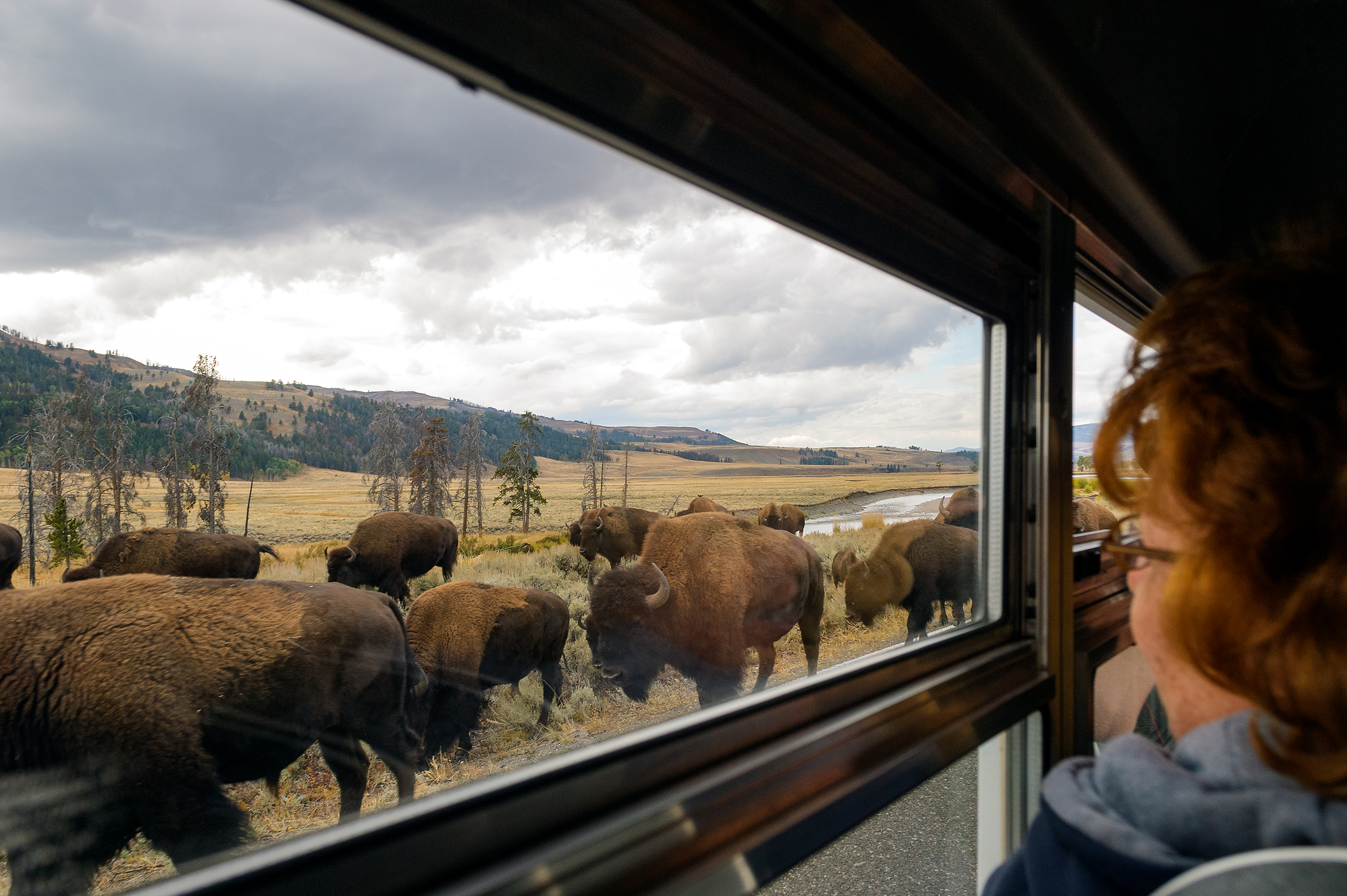
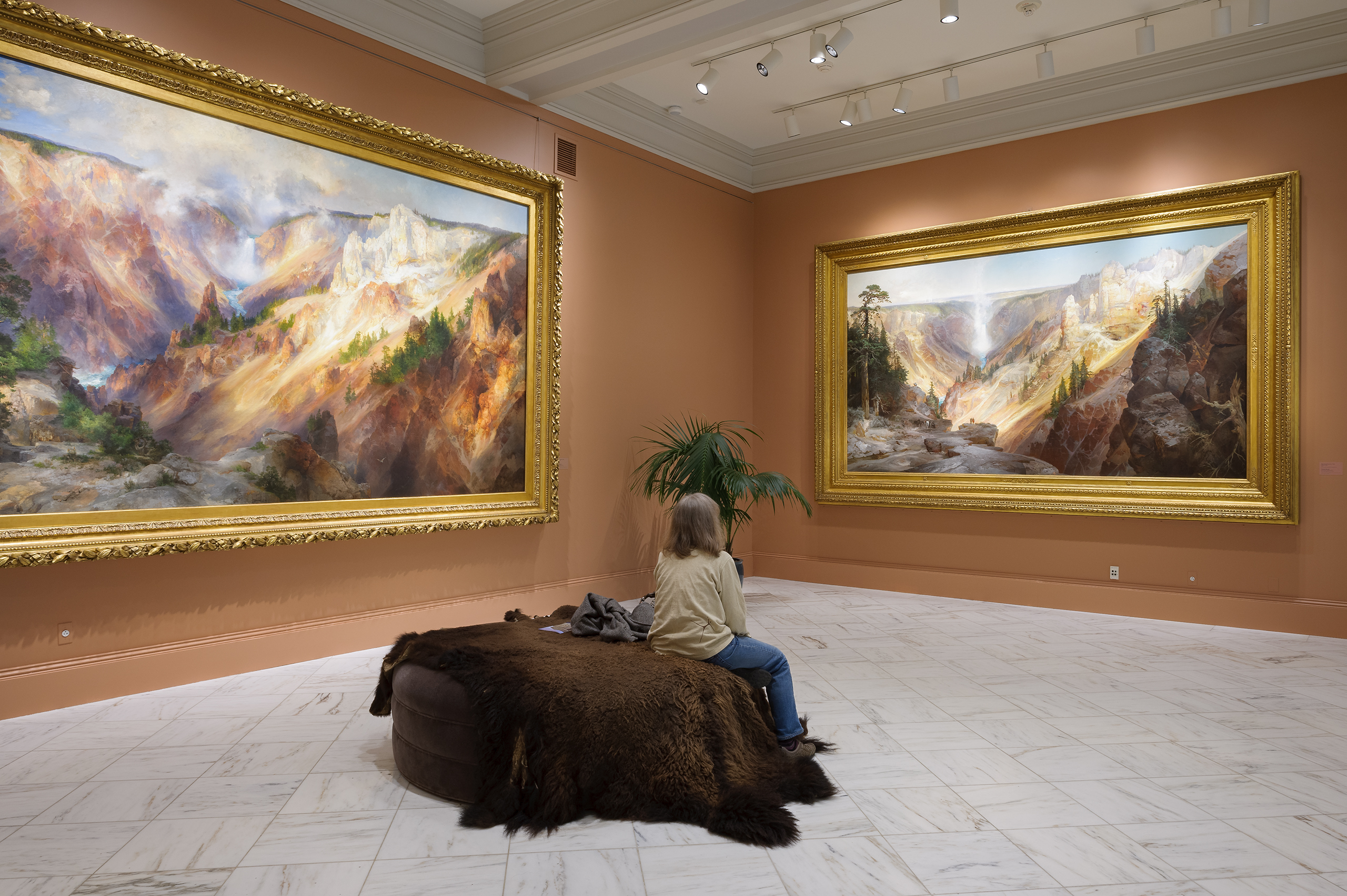
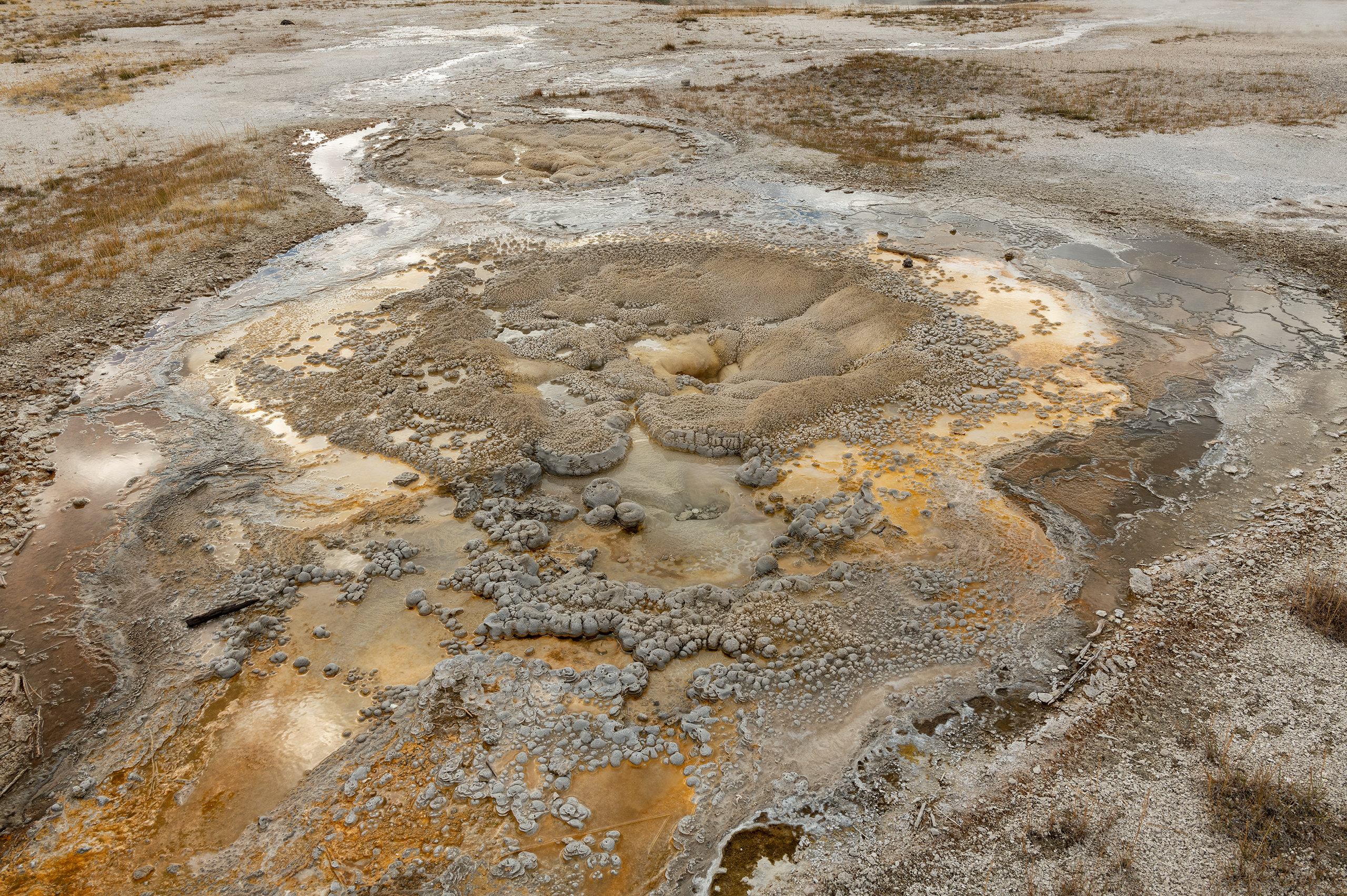
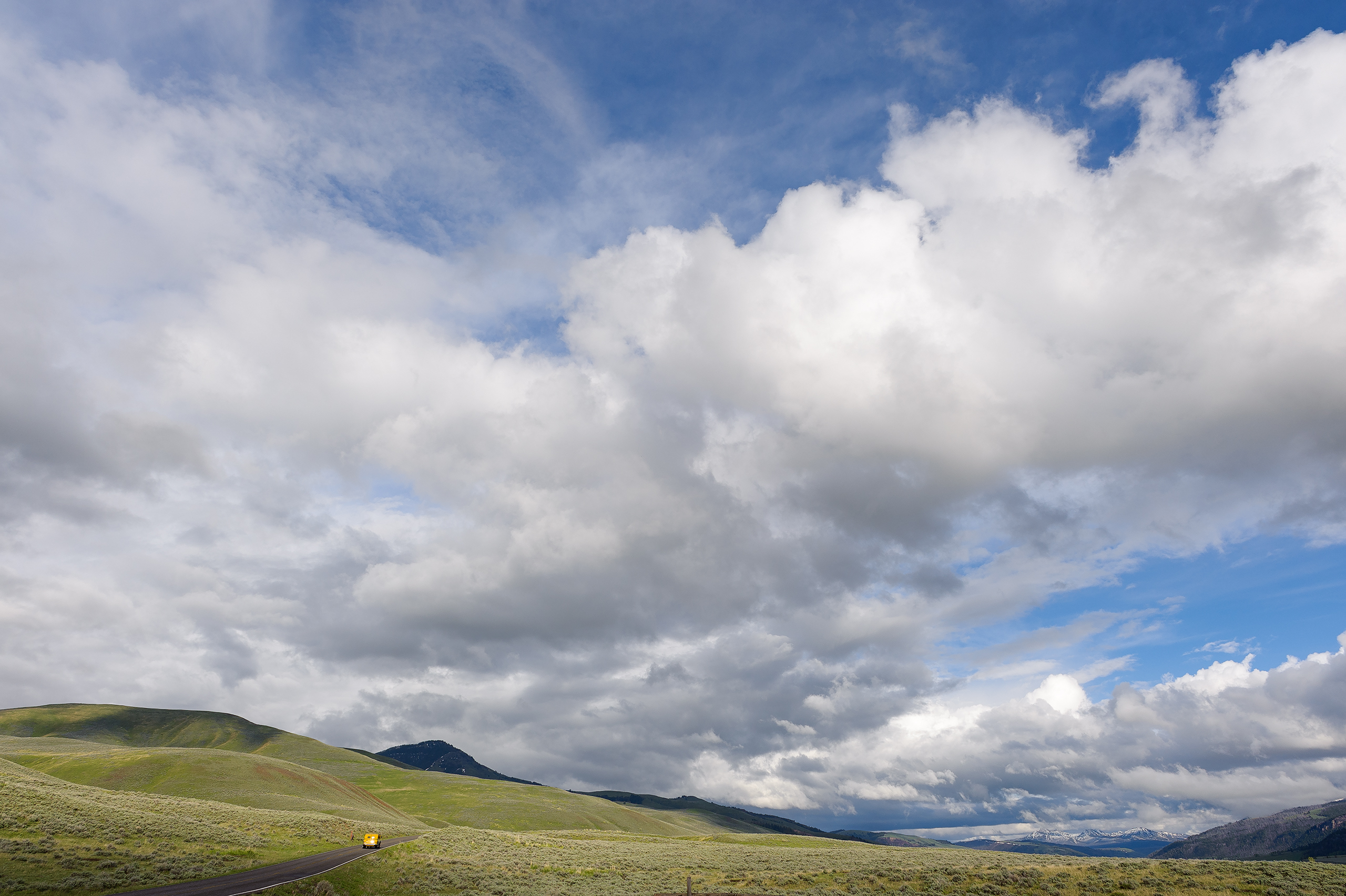
Bison: Primordial, Ominous, and Dark
Just like a traffic jam, only with elk or bison, this happens when herds surround vehicles, forcing traffic to a standstill, or a singular animal decides to stand firm on the double yellow line, clogging traffic and causing a backup.
Pritchard says one time she was stuck in a bison jam for at least an hour, “You can’t be in a hurry. You have to go with the flow.”
While stuck in that jam, Pritchard says she was on a narrow road with a steep shoulder on one side and a drop to the Yellowstone River on the other. The bison were coming through the landscape, in a wave-like now-you-see-them-now-you-don’t flow.
“Being in the midst of bison, they’re primordial like sharks. They’re one of those animals that feels ancient,” she says. “In this jam, as I watched them, this feeling came over me. There was something ominous and dark about their presence. I was describing this to a biologist I was hanging out with, and she said the bison’s eyes are not like ours. They do not reflect light, so there is no catchlight and that’s where a sense of life comes from when you look at another animal or a person. That’s not there, so they feel like they don’t have a soul.”
She admits that having wild animals in such proximity can be frightening, mainly because they’re unpredictable and slow moving - until they aren’t. An adult male bison, the largest animal in Yellowstone, can weigh as much as a compact car.
That’s from where the advice to keep someone else between you and the animals comes and the recommendation from another biologist friend to move away if you’re close enough to change an animal’s behavior.
Distance is key.
“You’ll see people standing around with spotting scopes and a lot of them, if they have something in their frame, will let you look if you don’t have your own,” Pritchard says. “People with high-end binoculars will get only 10x magnification, whereas spotting scopes are more like 60. That’s how you get a really good view.”
Still, some of the tiniest creatures in Yellowstone – the thermophiles that thrive in the heat of the geothermal springs and give places like the Morning Glory Pool its vibrant color - need only the naked eye to see their brilliance.
Biggest Threat is People
Millions of vacationers visit Yellowstone annually, oftentimes for the trip of a lifetime, putting lodging at a premium especially during the height of the season from mid-June to mid-September when public schools are generally on break.
Pritchard says the roads get plowed, allowing for vehicular traffic, in mid-April and stay open through mid-October, which means the slow season – and by that she means still busy but not as crowded – is generally before Memorial Day and after Labor Day, the best times to avoid masses of people.
People have been the biggest enemy of the park since the 1880s, she explains. Not only have they thrown trash into places like Morning Glory Pool, muting its exquisite colors in the process, but in the late 1800s people were taking home parts of the park as souvenirs.
“There’s a big military history in this area and that was to protect the park,” she says. “While the military is now gone, there are two types of rangers in the park. One of them is interpretive and charged with interacting with people, helping them with information. The other is law enforcement. These folks are not there first and foremost for the people, despite what we think. They’re actually there to protect the park and the animals from the people.”
Just off the Grand Loop Road, west of the Tower-Roosevelt junction, stands a lone petrified tree surrounded and protected by a 6- to 8-foot-tall iron fence. It’s not just a metaphor for the park itself, but a reminder of the damage people can do.
Pritchard explains that when the park was established in 1872 there was no federal funding attached to the designation, and people started looting within its new boundaries, including the piece-by-piece dismantling of a second petrified tree that once stood adjacent to its twin. The iron fence was erected to protect what remains of the first tree, and the military moved in to ensure that type of looting doesn’t happen again.
Everyone Has a Yellowstone Story
During her work on “More than Scenery,” Pritchard spent time at the American Antiquarian Society in Worcester, Massachusetts, researching the park through maps, historic pictures, and artifacts, often seeing the same researchers day after day.
“I can’t tell you how many people, while I’ve been working on this project, have shared their Yellowstone stories with me,” she says, including one woman in that library who professed she had no story to offer only to return a few days later with one.
“She proceeded to tell me that she was at a conference in the Jackson, Wyoming, area and she and her husband had a rental car, so they decided to go to the park. As they started driving in, it got smokey, and they couldn’t figure out why until they got back and checked the news,” Pritchard says. “It was the start of the fires of ’88.”
Pritchard was visiting Boulder, Colorado, in the summer of 1988 and also saw the smoke from the Yellowstone fires. Twenty years later, when she was in the park in 2008, Pritchard says she noticed the trees around her were the same kind of pine and roughly the same size, 12 to 14 feet tall, new growth forest.
“I realized what I was seeing was a burn matrix from the fires of ’88,” Pritchard says, noting that one can still wipe the soot off some burned trees.
Firefighters sought to suppress wildfires in the park before 1988, when 800,000 acres of Yellowstone burned, and they realized that strategy allowed for too much fuel to accumulate in the woodlands. Pritchard says fires now are left to burn themselves out unless historic structures or people are threatened.
Nevertheless, in 2016, a series of fires burned in the park, far sooner than the 100 years expected to yield enough fuel.
“What that said to them was fire management would have to be a lot more aggressive than anyone had ever imagined. We’ve seen what’s happened and played out in California. It’s a huge concern. There are a lot of areas, including parts of Montana and Colorado, where they just expect and accept that August skies will be cloudy from fire smoke the whole month – and that’s thanks to climate change,” Pritchard says.
Despite spending years in the Yellowstone area and gaining the kind of familiarity and understanding of it that only an expert can have, Pritchard says she’s “in a funny place, where I’m not really a local and I’m not a regular visitor, either. I’m in between.”
She adds, “It’s not a place I would have fully appreciated when I was younger, because of the people and the commercialization of it in a lot of ways. But the park is special. It really is much more interesting and complex than one first realizes.”
